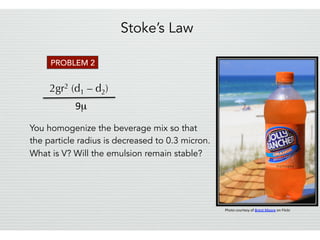Stoke's law
- 1. Stoke’s Law Photo courtesy of Patrick Willems on Flickr Prof. Abd Karim Alias Universiti Sains Malaysia
- 2. Stoke's Law calculates rate of destabilization of an emulsion by equating gravitational force with the opposing hydrodynamic force: where V = velocity of separation (or rate of creaming), cm/sec; g = acceleration of gravity (980 cm/sec); r = droplet radius (cm); d1 = density of disperse phase (g/cm3); d2 = density of continuous phase (g/cm3); µ = viscosity of the continuous phase (g/cm.sec) (µ = 0.01 at 20 °C) Stoke’s Law 2gr2 (d1 – d2) 9µ
- 3. You are making orange soda from an orange flavor emulsion. The density of the orange oil is 0.85 g/cm3, the density of a 10% sugar solution is 1.04 g/cm3, the average particle radius is 3.0 micron, and µ = 0.01 g/ cm·sec. What is V? Will the emulsion remain stable? Stoke’s Law PROBLEM 1 2gr2 (d1 – d2) 9µ Photo courtesy of Brent Moore on Flickr
- 4. You homogenize the beverage mix so that the particle radius is decreased to 0.3 micron. What is V? Will the emulsion remain stable? Stoke’s Law PROBLEM 2 2gr2 (d1 – d2) 9µ Photo courtesy of Brent Moore on Flickr
- 5. You add brominated vegetable oil to the orange oil so the overall density is 0.95 g/ cm3 . What is V for particle radius 3.0 micron? For 0.3 micron? Will the emulsion remain stable? Stoke’s Law PROBLEM 3 2gr2 (d1 – d2) 9µ Photo courtesy of Brent Moore on Flickr
- 6. For the above problems, which approach stabilized the emulsion more -- decreasing particle size or increasing density of the dispersed phase? Stoke’s Law PROBLEM 4 2gr2 (d1 – d2) 9µ Photo courtesy of Brent Moore on Flickr






